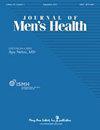COVID-19和勃起功能障碍
IF 0.6
4区 医学
Q4 Medicine
引用次数: 1
摘要
背景:SARS-CoV-2病毒对呼吸系统、消化系统和生殖系统有很强的影响,并引发了对其长期影响的质疑。勃起功能障碍是指男性在性交过程中无法达到或维持勃起,通常由生理和心理因素引起。SARS-CoV-2可以影响内皮组织周围的血管系统,因此提出了SARS-CoV-2感染与勃起功能障碍(ED)之间可能存在关系的问题。到目前为止,还没有研究建立COVID-19和ED之间的关系。在这篇综述中,我们分析了现有的数据,并总结了目前已知的COVID-19和ED之间关系的概念。这样的研究可能有助于泌尿科医生和男科医生管理ED和COVID-19感染史的患者。方法:采用系统评价方法分析COVID-19与ED的关系,并在谷歌Scholar、PubMed和ResearchGate三个数据库进行文献检索。搜索词包括COVID-19、勃起功能障碍和SARS-CoV-2。截至2021年12月,所有可用的研究都进行了分析。结果:新冠肺炎大流行导致男性生殖和性健康诊断(包括ED)显著增加,数据显示,新冠肺炎使男性患ED的几率增加了近6倍。在感染COVID-19的男性的生殖系统中也发现了生理问题。例如,与从未感染过COVID-19的严重ED患者相比,COVID-19阳性患者的内皮祖细胞水平要低得多。然而,目前尚不清楚在生殖系统中发现SARS-CoV-2的一致性,因为一项研究显示,生殖系统中只有五分之二的睾丸呈SARS-CoV-2阳性,另一项研究显示,26例中只有3例存在血睾丸屏障内皮、精管和附睾精子中的SARS-CoV-2尖峰。结论:COVID-19与ED之间存在许多相关性,但必须完成未来的测试和研究以确定COVID-19与ED之间的因果关系。本文章由计算机程序翻译,如有差异,请以英文原文为准。
COVID-19 and Erectile Dysfunction
Background: The SARS-CoV-2 virus displays a strong impact on the respiratory, digestive, and reproductive systems, and has led to questions about long-term effects. Erectile dysfunction is the inability for a male to achieve or sustain an erection during sexual intercourse, and commonly develops in men due to both physiological and psychologic factors. SARS-CoV-2 can affect the vasculature that surrounds endothelial tissue and thus has raised the question of a possible relationship between SARS-CoV-2 infection and erectile dysfunction (ED). Thus far, no studies have established a relationship between COVID-19 and ED. In this review, we analyze current available data and summarize the concepts regarding the current known relationship between COVID-19 and ED. Such a study might be helpful for urologists and andrologists to manage patients with ED and a history off COVID-19 infection. Methods: A systematic review was used to analyze the relationship between COVID-19 and ED. A literature search on three databases, Google Scholar, PubMed, and ResearchGate was conducted. Search terms used were COVID-19, erectile dysfunction, and SARS-CoV-2. All available studies were analyzed up to December 2021. Results: The COVID-19 pandemic led to a significant increase in male reproductive and sexual health diagnoses, including ED, with numbers showing that COVID-19 increases the chance of developing ED nearly sixfold. Physiological issues were also found in the reproductive system of men who had contracted COVID-19. For example, endothelial progenitor cells were much lower in patients positive with COVID-19 even when compared to men with severe ED who had never contracted COVID-19. However, it is still not clear how consistent it is to find SARS-CoV-2 in the reproductive system as one study showed only two out of five testes were positive for SARS-CoV-2 in the reproductive system and another study showed that there were only 3 out of 26 cases in which the SARS-CoV-2 spike existed in the endothelia of the blood-testis barrier, seminiferous tubules, and sperm of the epididymis. Conclusions: Many correlations can be made between COVID-19 and ED. However, future testing and research must be completed to determine a causal relationship between COVID-19 and ED.
求助全文
通过发布文献求助,成功后即可免费获取论文全文。
去求助
来源期刊

Journal of Men's Health
Medicine-Urology
CiteScore
0.70
自引率
28.60%
发文量
153
审稿时长
10 weeks
期刊介绍:
JOMH is an international, peer-reviewed, open access journal. JOMH publishes cutting-edge advances in a wide range of diseases and conditions, including diagnostic procedures, therapeutic management strategies, and innovative clinical research in gender-based biology. It also addresses sexual disparities in health, life expectancy, lifestyle and behaviors and so on. Scientists are encouraged to publish their experimental, theoretical, and descriptive studies and observations in as much detail as possible.
 求助内容:
求助内容: 应助结果提醒方式:
应助结果提醒方式:


